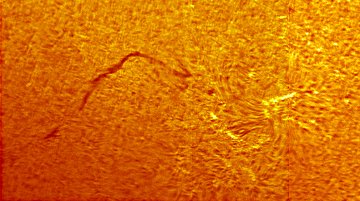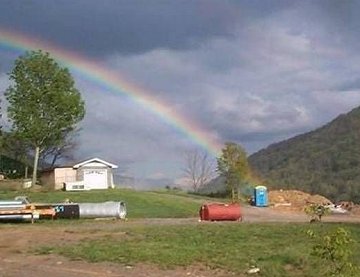| FLYBY ALERT! Would you like a phone call when the International Space Station (ISS) is about to fly over your back yard? Sign up for Space Weather PHONE. | | | SUNDAY MORNING WAKE-UP: Set your alarm for dawn. On Sunday morning, April 27th, Jupiter and the Moon will gather together for a lovely sunrise sky show. The two are so bright, they're visible even after the sky turns morning blue and all other stars and planets have faded away. Look out any south- or east-facing window and--presto!--you're wide awake, no coffee required. [sky map] SOLAR ACTIVITY UPDATE: Today at 1405 UT, the sun unleashed a B3-class solar flare near one of the filaments described below. In the Netherlands, amateur astronomer Emiel Veldhuis was photographing the sun when the flare occured and he captured the explosion. The blast hurled a coronal mass ejection (CME, image) into space; it is too soon to say whether it is on an Earth-intercept trajectory. Stay tuned for updates. SOLAR FILAMENTS: There's more to solar activity than sunspots. Consider today's sun, devoid of sunspots but criss-crossed with dark, writhing filaments like this one: 
John Stetson and student B. Atkins took the picture from South Portland, Maine, on April 25th. "We saw lots of very nice solar activity that included a bright prominence, a number of active areas, and this large filament," says Stetson. Solar filaments are long, sinuous clouds of hydrogen held above the surface of the sun by magnetic fields. They appear dark because they are cooler than the inferno below. For some reason--call it "solar weather"--the sun has broken out in a rash of filaments this weekend. At least half a dozen can be seen in backyard solar telescopes; if you have one, take a look. more images: from Paulo Casquinha of Quinta do Anjo, Palmela - Portugal; from Malcolm Park of London, England, UK; from Stephen Ames of Hodegenville, KY; from Will Gater of Bristol, UK; from Patricia Cannaerts of Belgium; from Joel Bavais of Anvaing, Belgium; END OF THE RAINBOW: At long last, Lorne Thompson of Las Vegas, Nevada, has found out what lies at the end of the rainbow. It's an outhouse: 
You were expecting a pot of gold? "Potty of gold" is more like it. Actually, there is no end to a rainbow. If the ground were removed, you would see that the rainbow makes a complete circle; this is called the "rainbow cone." Usually, less than half of the circle is visible because ground, hills and little blue buildings get in the way. To see more than half, go to the lofty perch of a mountaintop or an airplane. Voila!--no outhouse. more images: from Steve Wainwright of South Wales UK; from Aslaug Ally of Ski, Norway; from Gary Shunk of Boulder, Colorado; from Grzegorz Willim of Jeleśnia, Polska; from Helmut Groell of Krefeld, Germany
| 
